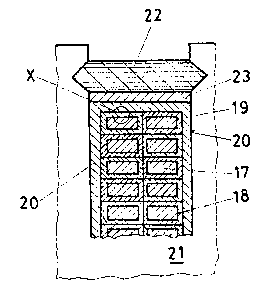Une partie des informations de ce site Web a été fournie par des sources externes. Le gouvernement du Canada n'assume aucune responsabilité concernant la précision, l'actualité ou la fiabilité des informations fournies par les sources externes. Les utilisateurs qui désirent employer cette information devraient consulter directement la source des informations. Le contenu fourni par les sources externes n'est pas assujetti aux exigences sur les langues officielles, la protection des renseignements personnels et l'accessibilité.
L'apparition de différences dans le texte et l'image des Revendications et de l'Abrégé dépend du moment auquel le document est publié. Les textes des Revendications et de l'Abrégé sont affichés :
| (12) Demande de brevet: | (11) CA 2094482 |
|---|---|
| (54) Titre français: | ISOLATION HAUTE TENSION POUR ENROULEMENTS D'INDUIT DE MOTEURS ELECTRIQUES |
| (54) Titre anglais: | HIGH-VOLTAGE INSULATION FOR STATOR WINDINGS OF ELECTRIC MACHINES |
| Statut: | Réputée abandonnée et au-delà du délai pour le rétablissement - en attente de la réponse à l’avis de communication rejetée |
| (51) Classification internationale des brevets (CIB): |
|
|---|---|
| (72) Inventeurs : |
|
| (73) Titulaires : |
|
| (71) Demandeurs : |
|
| (74) Agent: | NORTON ROSE FULBRIGHT CANADA LLP/S.E.N.C.R.L., S.R.L. |
| (74) Co-agent: | |
| (45) Délivré: | |
| (22) Date de dépôt: | 1993-04-20 |
| (41) Mise à la disponibilité du public: | 1993-12-11 |
| Requête d'examen: | 2000-04-06 |
| Licence disponible: | S.O. |
| Cédé au domaine public: | S.O. |
| (25) Langue des documents déposés: | Anglais |
| Traité de coopération en matière de brevets (PCT): | Non |
|---|
| (30) Données de priorité de la demande: | ||||||
|---|---|---|---|---|---|---|
|
ABSTRACT OF THE DISCLOSURE
The conductor bars of stator windings of
rotating electric machines are usually multiply wound
around with two-layer mica strips as major insulation
and then impregnated with synthetic resin. It is
proposed to use as first layer (L1) a mica strip which
is provided on both sides with a textile carrier (24,
25). The further layers (L2, L3, L4, ...) are then
wound with a mica strip (27) provided with a textile
carrier (28) only on one side.
A major insulation constructed in this way is
very homogeneous. The textile carrier (24), preferably
consisting of glass fabric, which bears directly on the
conductor surface, optimizes the impregnation and
produces an effective bond between the insulation and
conductor.
(Figure 3)
Note : Les revendications sont présentées dans la langue officielle dans laquelle elles ont été soumises.
Note : Les descriptions sont présentées dans la langue officielle dans laquelle elles ont été soumises.

2024-08-01 : Dans le cadre de la transition vers les Brevets de nouvelle génération (BNG), la base de données sur les brevets canadiens (BDBC) contient désormais un Historique d'événement plus détaillé, qui reproduit le Journal des événements de notre nouvelle solution interne.
Veuillez noter que les événements débutant par « Inactive : » se réfèrent à des événements qui ne sont plus utilisés dans notre nouvelle solution interne.
Pour une meilleure compréhension de l'état de la demande ou brevet qui figure sur cette page, la rubrique Mise en garde , et les descriptions de Brevet , Historique d'événement , Taxes périodiques et Historique des paiements devraient être consultées.
| Description | Date |
|---|---|
| Inactive : CIB de MCD | 2006-03-11 |
| Demande non rétablie avant l'échéance | 2003-04-22 |
| Le délai pour l'annulation est expiré | 2003-04-22 |
| Réputée abandonnée - les conditions pour l'octroi - jugée non conforme | 2002-07-24 |
| Réputée abandonnée - omission de répondre à un avis sur les taxes pour le maintien en état | 2002-04-22 |
| Un avis d'acceptation est envoyé | 2002-01-24 |
| Un avis d'acceptation est envoyé | 2002-01-24 |
| Lettre envoyée | 2002-01-24 |
| Inactive : Approuvée aux fins d'acceptation (AFA) | 2002-01-09 |
| Lettre envoyée | 2000-04-27 |
| Inactive : Renseign. sur l'état - Complets dès date d'ent. journ. | 2000-04-27 |
| Inactive : Dem. traitée sur TS dès date d'ent. journal | 2000-04-27 |
| Toutes les exigences pour l'examen - jugée conforme | 2000-04-06 |
| Exigences pour une requête d'examen - jugée conforme | 2000-04-06 |
| Demande publiée (accessible au public) | 1993-12-11 |
| Date d'abandonnement | Raison | Date de rétablissement |
|---|---|---|
| 2002-07-24 | ||
| 2002-04-22 |
Le dernier paiement a été reçu le 2001-03-27
Avis : Si le paiement en totalité n'a pas été reçu au plus tard à la date indiquée, une taxe supplémentaire peut être imposée, soit une des taxes suivantes :
Veuillez vous référer à la page web des taxes sur les brevets de l'OPIC pour voir tous les montants actuels des taxes.
| Type de taxes | Anniversaire | Échéance | Date payée |
|---|---|---|---|
| TM (demande, 5e anniv.) - générale | 05 | 1998-04-20 | 1998-03-23 |
| TM (demande, 6e anniv.) - générale | 06 | 1999-04-20 | 1999-03-22 |
| TM (demande, 7e anniv.) - générale | 07 | 2000-04-20 | 2000-03-17 |
| Requête d'examen - générale | 2000-04-06 | ||
| TM (demande, 8e anniv.) - générale | 08 | 2001-04-20 | 2001-03-27 |
Les titulaires actuels et antérieures au dossier sont affichés en ordre alphabétique.
| Titulaires actuels au dossier |
|---|
| ASEA BROWN BOVERI LTD. |
| Titulaires antérieures au dossier |
|---|
| ROLAND SCHULER |